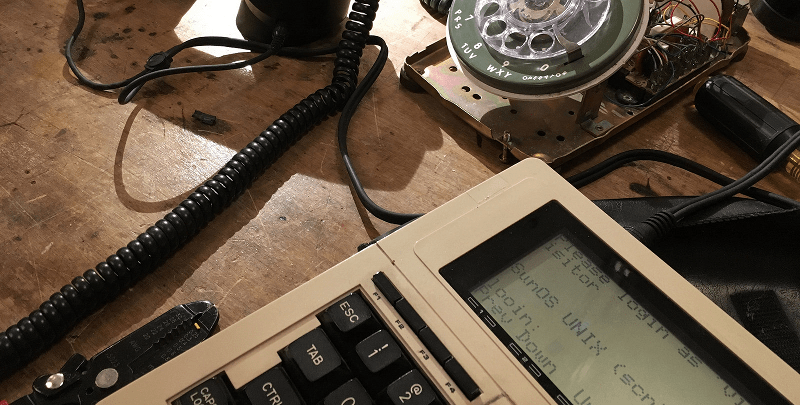There are a few old products that have rabid fan bases, and the TRS-80 Model 100 is one of those. Depending on your point of view it’s either a small laptop or a large organizer, but in 1983 it was the ultimate computer on the go. The $1100 version had a whopping 8K of memory and the LCD screen showed 8 lines of 40 characters in glorious monochrome. One cool feature was the built-in 300 baud phone modem, which [Trammell Hudson] wanted to try, but he doesn’t have a landline. He tried a VOiP phone, but it wouldn’t wedge into the acoustic couplers well enough. Then he decided to go cellular.
He had already hooked up an old ITT 500 series dial phone to an Adafruit Fona ceullar board. He even has Teensy software to decode the dial, drive the dial tone and otherwise make the phone work. This time he hooked a handset up through a headset jack.
It worked — at least mostly. It turns out that the Model 100 doesn’t speak PPP or fancy ANSI artwork, so a lot of dial up services were not workable. But it did work. [Trammell] noted that there was a little noise which would cause errors, but that was all part of using an acoustic modem — people have just forgotten how a slammed door or a car horn would show up in your data stream.
We have actually seen practical uses for acoustic couplers and cell phones, as you might recall. If you have a dead Model 100 you want to hack, you can always add a Raspberry Pi.















Federal Bureau of Investigation Special Agent Dale Cooper used one. And yes, the owls are not what they seem.
When I read the line:
“He tried a VOiP phone, but it wouldn’t wedge into the acoustic couplers well enough.”
I thought you meant there was some core incompatibility with the acoustic system and compression on the VOIP system or something. But no, reading the article, it literally just wouldn’t fit. The picture at the top was also a bit confusing with the rotary phone and all, but looking at the article I guess there isn’t actually a picture of the cell phone hooked up.
Anyway, now that we’ve seen this I wonder how long until somebody mods a little GSM module into the M100?
The compression used in cellular phones isn’t all that compatible with modems, but I guess you can get away with a lot at 300 baud.
Search amazon for “retro handset for cell phones” for an off-the-shelf TRRS headphone jack -> handset that will certainly work with an acoustic coupler. No wiring hacks required. (Would be curious how well these retro handsets would work…)
I got a tiny one of those in an xmas cracker! Admittedly a cracker you could put your own toys into, my sister planned it for me all along. It’s great though! Like having a telephone box in your pocket, or being a telephone box.
It’s about as long as your finger, red, and old-fashioned handset looking. Great fun, and only a couple of quid to buy.
But, of course, they have “full size” handsets too. (I assume you realize that.)
I wish crackers I buy had stuff like tiny handsets in ’em. Or packs of thru-hole parts. :)
For the Americans: https://en.wikipedia.org/wiki/Christmas_cracker
Although I knew what a Christmas cracker was, I admit that the amusing image of a saltine cracker large enough to hide a model 500 handset did dance through my head.
Long ago and far away I was responsible for proofreading the service manual for the M100 (and subsequent M200, the attached 3.5″ disk drive and the ever popular Expansion Bay and teaching the RS field service staff how to repair them. I still have the original copy with all my proofreading corrections in it. Including all the notes used to create the termcap entry for it.
The design of the machine is incredibly simple, I’m surprised someone with even moderate hacking skills could not fix it. One of the more useful features was the 40 pin expansion connector on the bottom that the expansion bay used. I built a 8 channel ADC/DAC board that hung off of it that I used in the lab for a long time to take analogue samples.
Grabbed mine out from under the workbench the other day for the first time in years. And it powered right up. Still a great serial terminal.
Anyone know of a program for the Model 100 that after you cable together over parallel or serial, receive data from an attached computer and display text / simple graphics on the Model 100.
Use the Model 100 as a display.